สวัสดีค่ะ เพื่อนๆ สายกินทุกคน! ดิฉันชื่อ Emma Lee บล็อกเกอร์ผู้หลงใหลในรสชาติอาหาร และได้อาศัยอยู่ในประเทศจีนมาหลายปีแล้ว ในฐานะคนที่ชอบค้นหาความอร่อยทุกรูปแบบ ไม่ว่าจะเป็นสตรีทฟู้ดแบบเรียบง่ายหรืออาหารชั้นสูงที่ประณีต ล้วนทำให้ฉันตื่นเต้นทุกครั้ง และวันนี้ฉันรู้สึกตื่นเต้นเป็นพิเศษที่จะพาทุกคนไปสัมผัสกับหนึ่งในเมนูจีนที่โด่งดังที่สุดอย่าง เป็ดปักกิ่ง ตั้งแต่ประวัติศาสตร์อันยาวนานไปจนถึงร้านชื่อดังในกรุงปักกิ่ง บทความนี้ฉันจะพาทุกคนไปผจญภัยในโลกแห่งรสชาติอันเป็นเอกลักษณ์นี้ด้วยกัน!
สารบัญบทความ
เป็ดปักกิ่งคืออะไร?
เป็ดปักกิ่ง (Peking Duck) คืออาหารจีนที่มีชื่อเสียงระดับนานาชาติ และเป็นสัญลักษณ์ของวัฒนธรรมการกินแห่งกรุงปักกิ่ง ต้นกำเนิดของมันสามารถย้อนกลับไปได้ตั้งแต่สมัยราชวงศ์เหนือ–ใต้ (คริสต์ศตวรรษที่ 5–6) ซึ่งในตอนนั้นเมนูเป็ดย่างถือเป็นอาหารหรูหราของราชสำนัก กาลเวลาผ่านไป เป็ดปักกิ่งค่อยๆ พัฒนาจนกลายเป็นอาหารที่เสิร์ฟเฉพาะให้จักรพรรดิและชนชั้นสูง แล้วอะไรทำให้เมนูนี้พิเศษจนเป็นที่รักของผู้คนทั่วโลก? มาลองเจาะลึกกันดู:
- รสชาติ: เนื้อเป็ดนุ่มฉ่ำ หนังกรอบ บาลานซ์ความมันและความหอมได้อย่างลงตัว
- วัตถุดิบหลัก: ใช้เป็ดสายพันธุ์พิเศษที่เลี้ยงเฉพาะ และย่างด้วยฟืนจากไม้ผล ให้กลิ่นหอมรมควันเฉพาะตัว
- เหมาะกับทุกวัย: ไม่ว่าจะผู้ใหญ่หรือเด็ก ต่างก็หลงรักเมนูนี้ รับประทานได้ทั้งครอบครัว
- สถานที่ที่ดีที่สุดในการลิ้มลอง: แม้ว่าจะหากินได้ทั่วโลก แต่รสชาติที่แท้จริงและดั้งเดิมที่สุด ต้องไปชิมที่ปักกิ่งเท่านั้น
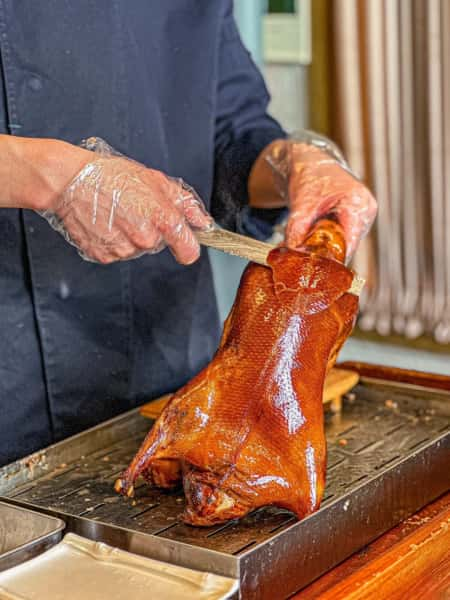
ทำไมเป็ดปักกิ่งถึงมีชื่อเสียงมาก?
นอกจากรสชาติอันยอดเยี่ยมแล้ว เป็ดปักกิ่ง ยังเต็มไปด้วยคุณค่าทางวัฒนธรรมและประวัติศาสตร์ มันไม่ได้เป็นเพียงอาหาร แต่เป็นสัญลักษณ์แห่งศิลปะการปรุงอาหารของจีน ด้วยกรรมวิธีการทำที่ซับซ้อนและเทคนิคการย่างที่ไม่เหมือนใคร ทำให้เป็ดปักกิ่งกลายเป็นอาหารสำคัญในงานเลี้ยงหรูหรา รวมถึงการรวมตัวในครอบครัวอีกด้วย
ในเวทีนานาชาติ เป็ดปักกิ่งยังถูกเลือกเสิร์ฟในหลายโอกาสสำคัญ ทำให้มันมีสถานะเหมือนทูตวัฒนธรรมที่ช่วยเชื่อมโยงประเทศจีนกับผู้คนทั่วโลกอย่างแท้จริง
ประวัติศาสตร์ของเป็ดปักกิ่ง
ต้นกำเนิดของเมนูนี้เริ่มขึ้นตั้งแต่สมัยราชวงศ์เหนือ–ใต้ (คริสต์ศตวรรษที่ 5–6) โดยในราชสำนักได้ยกให้เป็นอาหารเลิศรส ต่อมาในสมัยราชวงศ์ถัง (ค.ศ. 618–907) การย่างเป็ดค่อยๆ กลายเป็นเมนูยอดนิยมของชนชั้นสูง และในราชวงศ์หยวน (ค.ศ. 1271–1368) มีบันทึกว่าเชฟชื่อ Zhang ได้นำเมนูนี้ขึ้นโต๊ะเสวยในงานเลี้ยงของราชสำนัก ทำให้เป็ดปักกิ่งกลายเป็นเมนูสำคัญที่ได้รับการยกย่อง
เมื่อเวลาผ่านเข้าสู่ราชวงศ์หมิง (ค.ศ. 1368–1644) กรุงปักกิ่งได้กลายเป็นเมืองหลวงอย่างเป็นทางการ และเป็ดปักกิ่งก็ถูกปรับปรุงให้มีรสชาติและวิธีการทำที่ใกล้เคียงกับแบบปัจจุบัน อีกทั้งยังแพร่หลายไปสู่สามัญชนในวงกว้าง ตั้งแต่นั้นมา เป็ดปักกิ่งจึงไม่เพียงเป็นสมบัติทางอาหารของจีน แต่ยังเป็นหนึ่งในเมนูที่ได้รับความนิยมมากที่สุดในโลก แฝงไปด้วยคุณค่าทางวัฒนธรรมที่ลึกซึ้งและยั่งยืน
วิธีการกินเป็ดปักกิ่งแบบมือโปร
เป็ดปักกิ่งไม่ใช่เพียงแค่อาหารอร่อย แต่ยังเป็นประสบการณ์การกินที่ควรลิ้มลอง! ต่อไปนี้คือวิธีการกินที่ดีที่สุดที่จะทำให้คุณได้สัมผัสรสชาติของเมนูสุดคลาสสิกนี้ในหลายรูปแบบ:
วิธีที่ 1: กินกับแป้งห่อ (แป้งเหนียวบาง)
- ขั้นตอนที่ 1: ทาซอสหวานลงบนแป้งห่อที่เพิ่งอบร้อนๆ
- ขั้นตอนที่ 2: วางเนื้อเป็ดปักกิ่งหั่นบางๆ ลงไป
- ขั้นตอนที่ 3: เติมด้วยต้นหอมซอยและแตงกวาหั่นเส้น จากนั้นม้วนเหมือนโรลแล้วกัดคำโตๆ ได้เลย!
เคล็ดลับสำคัญคือความสดใหม่ของแป้งห่อ เพราะแป้งที่เพิ่งทำใหม่ๆ จะช่วยขับรสชาติของเป็ดปักกิ่งให้กลมกล่อมมากยิ่งขึ้น
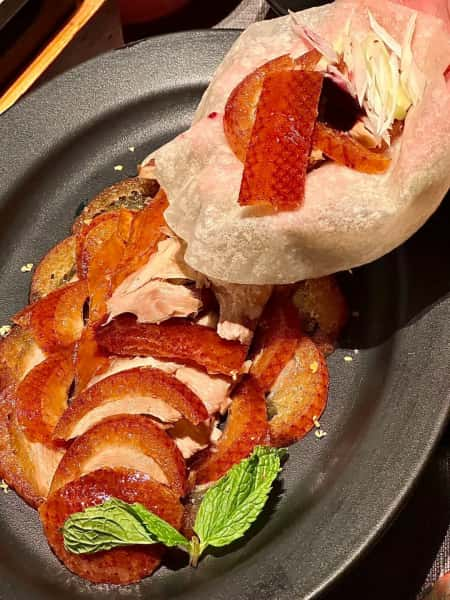
วิธีที่ 2: กินคู่กับกระเทียม ซอสถั่วเหลือง และหัวไชเท้าซอย
- ขั้นตอนที่ 1: บดกระเทียมสดแล้วคลุกกับซอสถั่วเหลืองเล็กน้อย
- ขั้นตอนที่ 2: หั่นหัวไชเท้าเป็นเส้นบางๆ
- ขั้นตอนที่ 3: นำเนื้อเป็ดกับหัวไชเท้า จิ้มกับซอสกระเทียมถั่วเหลือง แล้วกินพร้อมกันในคำเดียว
วิธีนี้ให้รสชาติที่ไม่เหมือนใคร ความเผ็ดฉุนสดชื่นของหัวไชเท้า ผสานกับรสเข้มข้นของเนื้อเป็ดและกลิ่นหอมของกระเทียม กลายเป็นการจับคู่ที่ลงตัว ทำให้เจริญอาหารสุดๆ
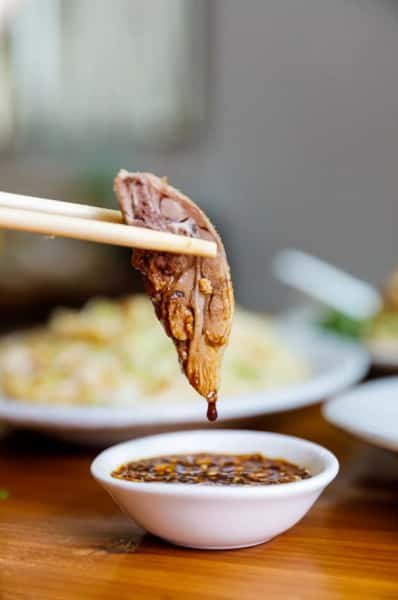
วิธีที่ 3: หนังเป็ดกรอบจิ้มกับน้ำตาล
สำหรับใครที่ชอบรสหวานหรืออยากได้รสสัมผัสเบาๆ ลองเอาหนังเป็ดกรอบไปจิ้มกับน้ำตาลดูสิ! วิธีนี้ง่ายแต่พิเศษ หนังกรอบหอมผสานกับความหวานอ่อนๆ กินแล้วเพลินจนหยุดไม่ได้
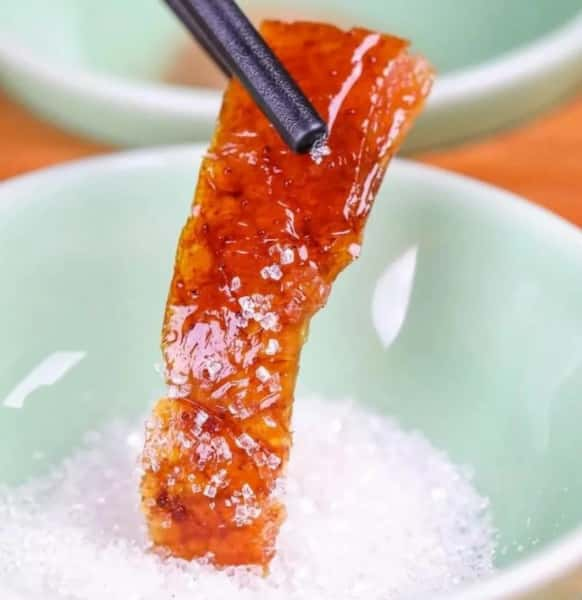
วิธีที่ 4: ซุปโครงเป็ด
หลังจากกินเนื้อเป็ดเสร็จแล้ว อย่าปล่อยให้โครงเป็ดเสียเปล่า! นำมาทำซุปได้รสกลมกล่อม กลิ่นหอมรมควันจากการย่างด้วยไม้ผลจะซึมเข้าสู่ซุป เมื่อเคี่ยวเบาๆ จะได้ซุปรสใส หอมอร่อย เป็นการปิดท้ายมื้ออาหารสุดหรูได้อย่างสมบูรณ์แบบ
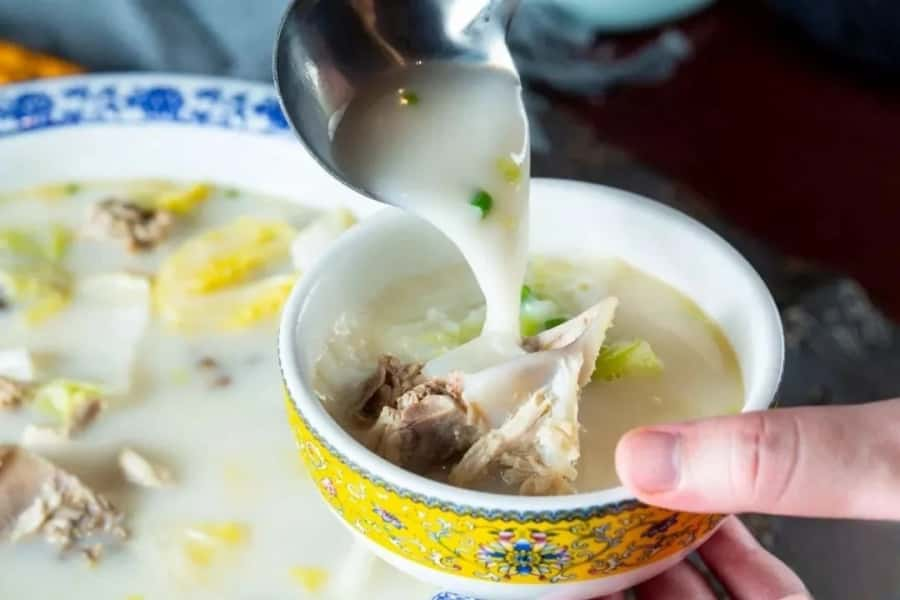
6 ร้านเป็ดปักกิ่งที่ต้องไปลองเมื่อมาเที่ยวปักกิ่ง
ตอนนี้คุณรู้แล้วว่าจะเพลิดเพลินกับเป็ดปักกิ่งอย่างไร ต่อไปฉันจะมาแชร์ร้านเด็ดในปักกิ่งที่ฉันคัดมาแล้วจากการตระเวนกินมาหลายปี ร้านเหล่านี้คือสวรรค์ของนักชิมที่ไม่ควรพลาด!
Quanjude (สาขา Hepingmen)
- ที่อยู่: เลขที่ 14 ถนน Qianmen West เขต Xicheng กรุงปักกิ่ง (ทางออก C2 สถานีรถไฟใต้ดิน Hepingmen เดิน 80 เมตร)
- ราคา: เฉลี่ยต่อคนประมาณ ¥179
- ไฮไลต์: โด่งดังเรื่องการใช้เทคนิค “แขวนอบ” ทำให้หนังกรอบ เนื้อนุ่ม Quanjude เปิดมากว่าร้อยปี ถือเป็นหนึ่งในตำนานร้านเป็ดปักกิ่ง
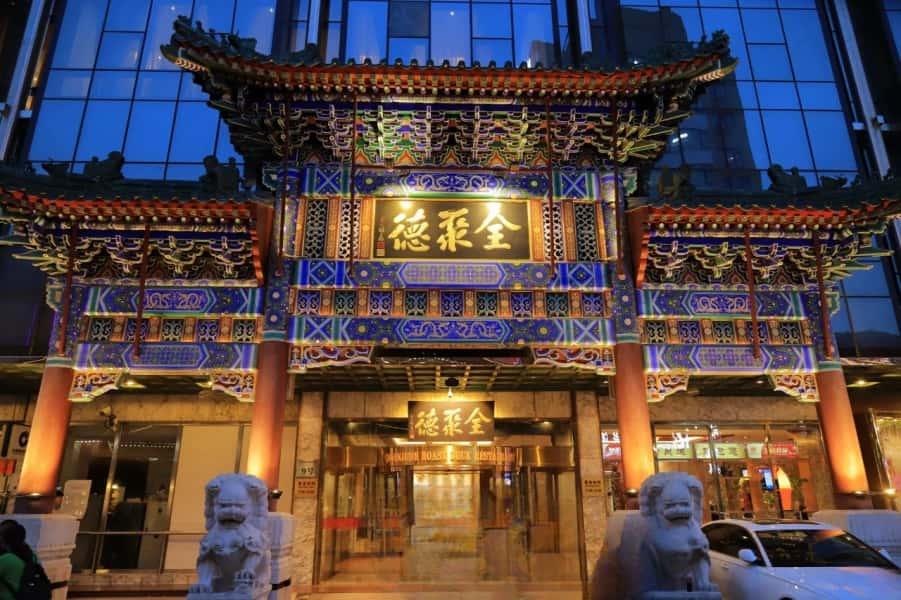
Bianyifang (สาขา Hademen)
- ที่อยู่: ชั้น 4 อาคาร Bianyifang ถนน Chongwai เขต Dongcheng กรุงปักกิ่ง
- ราคา: เฉลี่ยต่อคนประมาณ ¥123
- ไฮไลต์: มีชื่อเสียงด้านเทคนิคการอบ “หม้อปิด” ทำให้เนื้อเป็ดนุ่มฉ่ำ หนังออกนิ่ม เหมาะกับคนที่ชอบรสเข้มข้นแบบดั้งเดิม

Liqun Roast Duck
- ที่อยู่: เลขที่ 11 Hutong Beixiangfeng เขต Dongcheng กรุงปักกิ่ง
- ราคา: เฉลี่ยต่อคนประมาณ ¥120
- ไฮไลต์: ร้านเล็กๆ ที่ซ่อนตัวอยู่ในซือเหอย่วนแบบดั้งเดิมของปักกิ่ง บรรยากาศอบอุ่นและใกล้ชิด เสิร์ฟเป็ดปักกิ่งรสชาติต้นตำรับ พร้อมกับกับข้าวพื้นเมือง
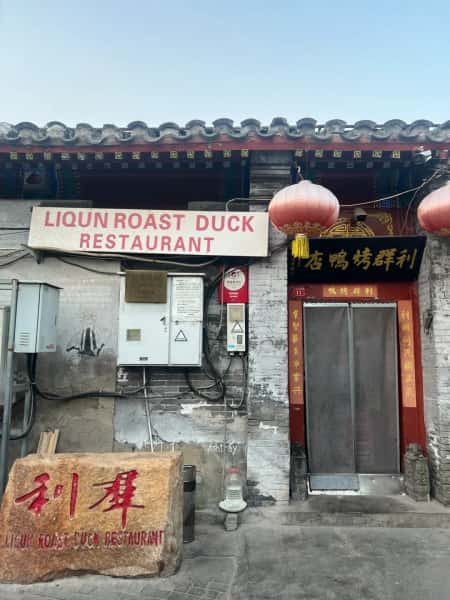
Da Dong (สาขา Shanghai iapm Mall)
- ที่อยู่: ชั้น 6 ห้าง iapm Mall ถนน Huaihai เขต Xuhui นครเซี่ยงไฮ้
- ราคา: เฉลี่ยต่อคนประมาณ ¥368
- ไฮไลต์: ร้านอาหารระดับมิชลินที่ขึ้นชื่อเรื่องการปรุงเป็ดปักกิ่งสไตล์โมเดิร์น เน้นความหรูหราและนำเสนอพร้อมกับเครื่องเคียงที่แปลกใหม่
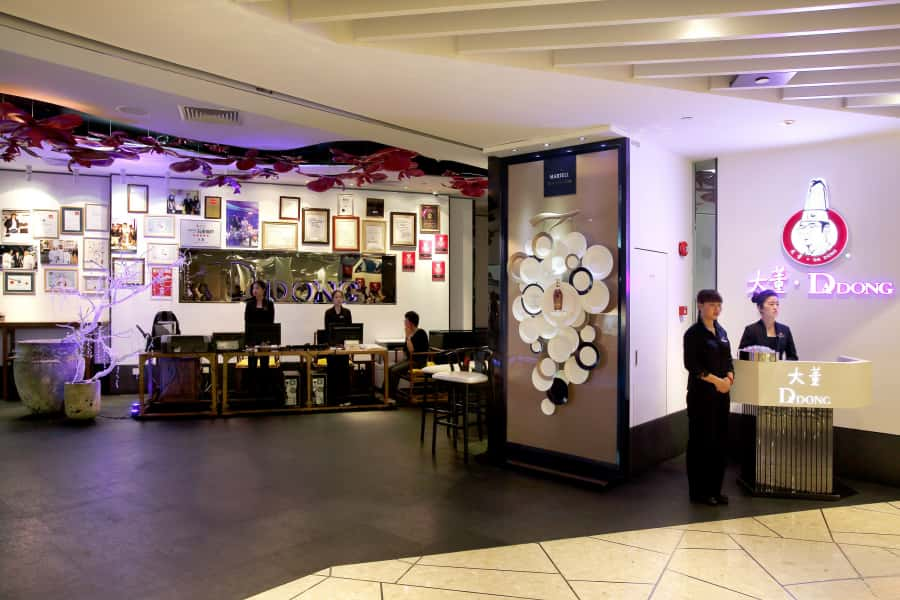
Siji Minfu (สาขา Forbidden City)
- ที่อยู่: เลขที่ 11 ถนน Nanchizi เขต Dongcheng กรุงปักกิ่ง
- ราคา: เฉลี่ยต่อคนประมาณ ¥145
- ไฮไลต์: ได้รับความนิยมทั้งจากคนท้องถิ่นและนักท่องเที่ยว โดยเฉพาะสาขาใกล้พระราชวังต้องห้าม ที่นี่ขึ้นชื่อเรื่องรสชาติดีเยี่ยมและบรรยากาศสุดพิเศษ

Ziguangyuan (สาขา Ritan)
- ที่อยู่: เลขที่ 6 ถนน Ritan North เขต Chaoyang กรุงปักกิ่ง
- ราคา: เฉลี่ยต่อคนประมาณ ¥61
- ไฮไลต์: ร้านเล็กๆ ที่ราคาสบายกระเป๋าแต่คุณภาพเกินคุ้ม เหมาะสำหรับคนที่อยากกินเป็ดปักกิ่งต้นตำรับในราคาย่อมเยา
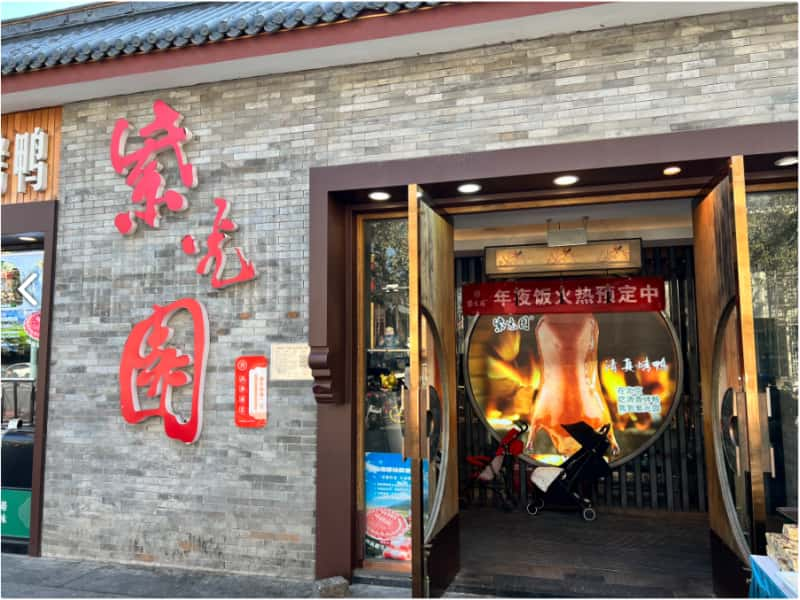
ที่ไหนสามารถซื้อเป็ดปักกิ่งเป็นของฝากได้บ้าง?
การนำรสชาติจากปักกิ่งกลับไปฝากครอบครัวและเพื่อนๆ ถือเป็นวิธีที่ยอดเยี่ยมในการแบ่งปันอาหารจีนสุดคลาสสิกนี้ อย่างไรก็ตาม เนื่องจากกฎการนำอาหารเข้าประเทศอาจแตกต่างกันไปในแต่ละประเทศ จึงแนะนำให้ซื้อเป็ดปักกิ่งแบบ แพ็คสูญญากาศ ซึ่งสะดวกต่อการพกพามากกว่า และนี่คือสถานที่ที่ฉันแนะนำสำหรับการเลือกซื้อ:
ซูเปอร์มาร์เก็ต
- ราคา: ประมาณ ¥75 ต่อตัว
- เนื้อหาในกล่อง: เป็ดปักกิ่งทั้งตัว, แป้งห่อ, ซอสหวาน
- เหตุผลที่แนะนำ: เป็นตัวเลือกที่สะดวกและคุ้มค่าที่สุด เหมาะกับผู้ที่อยากได้ของฝากง่ายๆ แต่ครบชุด เพราะมีทั้งเนื้อเป็ดและส่วนประกอบพื้นฐานสำหรับการลิ้มรส
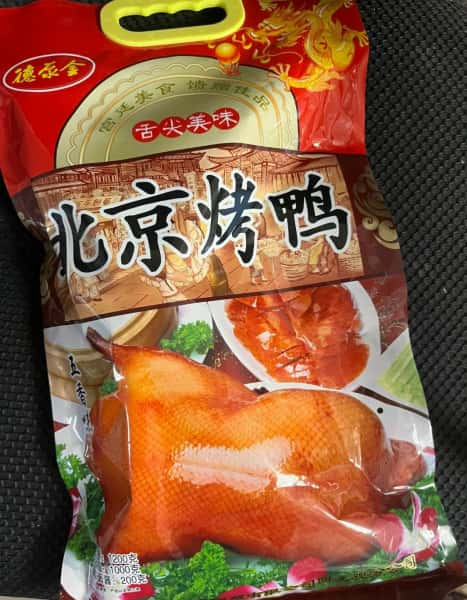
Ziguangyuan (สาขา Ritan)
- วิธีแพ็ค: สูญญากาศ ปลอดภัยและพกพาง่าย
- ราคา: ประมาณ ¥158 ต่อตัว
- เนื้อหาในกล่อง: เนื้อและหนังเป็ด 2 กล่อง, ซอสเป็ด 2 กล่อง, แป้งห่อ (มีแผ่นรองป้องกันติดกัน), เป็ดทั้งตัว, โครงเป็ด, ขาและปีก รวมทั้งเครื่องเคียงอย่างฮวาเจียว, น้ำตาล, กระเทียมบด, แตงกวา, ต้นหอม ฯลฯ
- เหตุผลที่แนะนำ: ชุดนี้มอบประสบการณ์เป็ดปักกิ่งแบบครบถ้วน มีการออกแบบบรรจุภัณฑ์ที่พิถีพิถัน รักษาความสดและรสชาติได้ดี ตั้งแต่หนังกรอบจนถึงซอสหอมเข้มข้น ทุกอย่างคัดสรรอย่างคุณภาพ เหมาะอย่างยิ่งสำหรับผู้ที่หลงรักอาหารจีนดั้งเดิมและต้องการของฝากที่ไม่ธรรมดา
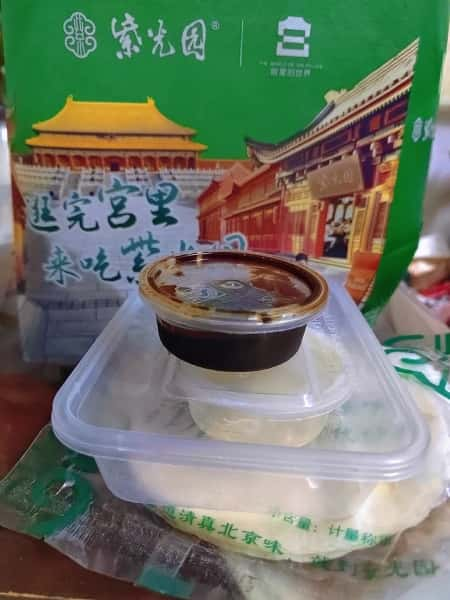
กระบวนการทำเป็ดปักกิ่ง
การทำเป็ดปักกิ่งถือเป็นศิลปะที่ละเอียดอ่อน ทุกขั้นตอนถูกออกแบบมาเพื่อให้ได้รสสัมผัสที่สมบูรณ์แบบ ต่อไปนี้คือเคล็ดลับสำคัญที่อยู่เบื้องหลังความอร่อย:
การเลือกเป็ด
ดั้งเดิมแล้วจะใช้ เป็ดพันธุ์ Beijing Fattened Duck ซึ่งมีตัวใหญ่และขนสีขาวบริสุทธิ์ เลี้ยงด้วยวิธีพิเศษโดยให้อาหารธัญพืชอย่างข้าวฟ่างและข้าวฟ้าวันละหลายครั้ง เป็ดแทบไม่ต้องหาอาหารเอง จึงถูกเรียกว่า “วิธีเลี้ยงอ้วน” หลังจากเป็ดถูกทำความสะอาดอย่างดี จะมีการใส่น้ำเข้าไปในท้องแล้วปิด เพื่อช่วยให้เนื้อยังคงนุ่มชุ่มฉ่ำระหว่างการย่าง
วิธีการย่าง: หม้อปิด และ แขวนย่าง
- หม้อปิด (Menlu): ใช้เตาที่ปิดสนิท เผาโดยใช้ฟางข้าวฟ่าง เมื่อตัวเตาร้อนพอแล้วก็ปิดไฟและใส่เป็ดเข้าไป ความร้อนที่เหลือจะอบจนเนื้อเป็ดนุ่มฉ่ำและมีรสเข้มข้น ร้าน Bianyifang เป็นตัวแทนที่มีชื่อเสียงของวิธีนี้
- แขวนย่าง (Gualu): ใช้ฟืนไม้ผลอย่างเช่นไม้พุทราหรือไม้แพร์ ให้กลิ่นหอมเฉพาะ เป็ดจะถูกแขวนไว้ในเตาเปิดและหมุนตลอดเวลาเพื่อให้สุกทั่ว หนังจะถูกย่างจนกรอบเป็นสีทอง ส่วนเนื้อยังคงนุ่มชุ่มฉ่ำ ร้าน Quanjude เป็นตัวแทนที่โดดเด่นของเทคนิคนี้
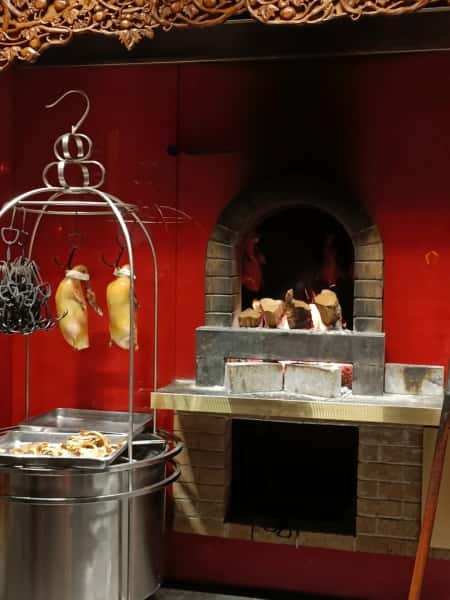
ขั้นตอนสุดท้าย: แล่เนื้อและเสิร์ฟ
เมื่อย่างเสร็จ เชฟจะแล่เนื้อเป็ดออกเป็นชิ้นบางๆ ขั้นตอนนี้เรียกว่า “Pian Ya” ซึ่งโดยมาตรฐานควรทำให้เสร็จภายใน 2 นาทีครึ่ง เนื้อเป็ดที่แล่แล้วมักเสิร์ฟพร้อมต้นหอม แตงกวา และซอสหวาน ห่อด้วยแป้งบาง รสสัมผัสกรอบของหนัง ความนุ่มของเนื้อ และความหวานเค็มของซอสผสมผสานจนเป็นรสชาติที่ลืมไม่ลง
และอย่าลืมว่า หลังจากเนื้อหมดแล้ว โครงเป็ดยังสามารถนำไปต้มซุปได้อีก เคี่ยวกับเครื่องเทศเล็กน้อยก็จะได้ซุปหอมเข้มข้นสำหรับปิดท้ายมื้ออาหารอย่างสมบูรณ์แบบ
วิธีการกินเป็ดปักกิ่งในร้านอาหาร
ที่ร้านอาหาร เป็ดปักกิ่งมักสั่งได้ทั้งตัวหรือครึ่งตัว โดยเป็ดหนึ่งตัวเหมาะสำหรับ 4–5 คน ส่วนครึ่งตัวเหมาะกับ 2–3 คน และเพื่อให้มื้ออาหารหลากหลายยิ่งขึ้น อย่าลืมสั่งเมนูท้องถิ่นชื่อดังของปักกิ่ง เช่น Zhajiangmian (บะหมี่ผัดซอสถั่ว) หรือ Zhizi Kaorou (หมูย่างบนเหล็ก) มากินคู่กัน จะทำให้มื้ออาหารสมบูรณ์และอร่อยยิ่งกว่าเดิม
รวมลิงก์แนะนำเที่ยวปักกิ่งที่จำเป็น
- คู่มือเที่ยวปักกิ่งฉบับสมบูรณ์ 📖
- แนะนำสถานที่ท่องเที่ยวและแผนเที่ยวปักกิ่ง🏙️
- แนะนำที่พัก 🏨
- คู่มือการเดินทาง ✈️ 🚇 🚄 🚆
- เคล็ดลับและข้อมูลจำเป็นในการท่องเที่ยว 🗺️ 🍜 📱 💸 🌤️ 💊

 English (US)
English (US)  繁體中文
繁體中文 
Comment (0)